Japan Wood Products
Prices
Dollar Exchange Rates of
25th August 2014
Japan Yen 104.06
Reports From Japan
State of the Japanese economy – assessment by BoJ
The Bank of Japan (BoJ) has determined in its latest
assessment that the Japanese economy is on a moderate
recovery track and that consumption is improving after the
huge boom in consumption just prior to the consumption
tax increase.
In the words of the BoJ:
Private consumption shows movements of
picking up, while some weakness remains.
Business investment shows some weak
movements recently, while it is on the increase.
Exports are flat.
Industrial production is in a weak tone with a
reaction after a last-minute rise in demand before
a consumption tax increase.
Corporate profit improvement appears to be
pausing.
Firms' judgment on current business conditions
is cautious, while it shows signs of improvement.
The employment situation is improving steadily.
Consumer prices are rising moderately.
On short-term prospects the BoJ warns that there remains
a downside risk to the economy if the negative impact of
the consumption tax increase continues. The government
has revised down its assessment of short-term factory
output and has indicated that if weakness in the economy
continues it will take action to sustain growth so that its
inflation goal is achieved.
The consensus amongst analysts is the third quarter GDP
growth will be around 3.5%.
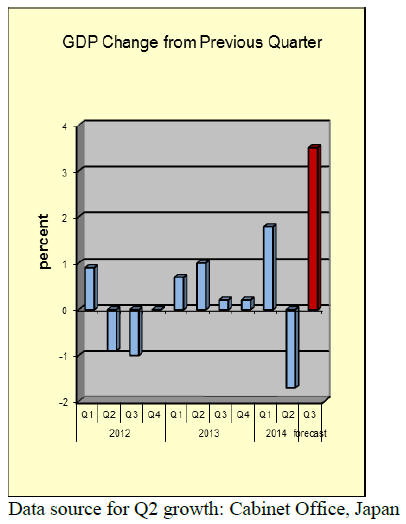
Fourth consecutive fall in household spending
Japan's Ministry of Internal Affairs and Communications
has released the results of its survey on household
spending showing an almost 6% decline in July compared
to June. This marks the fourth consecutive decline in
household spending since the consumption tax was raised.
August is vacation time in Japan but reports show a sharp
drop in holiday spending which added to the decline
already being experienced with sales of electronics and
cars.
The July data confirms what the BoJ had deduced, namely
that the effect of the consumption tax rise is taking longer
to dissipate than expected.
The biggest problem facing consumers is that wages are
not catching up with price rises and this puts a downward
pressure on household spending. The next consumer
confidence survey is expected to show persistent
weakness.
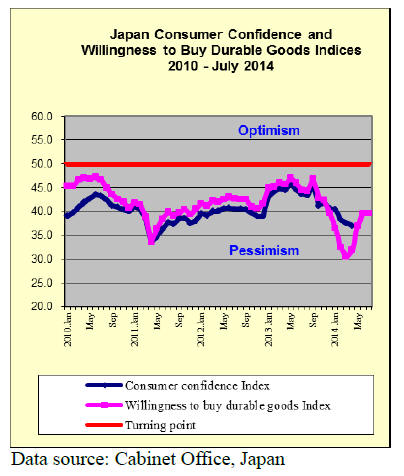
July housing starts reverse course
Japan‟s Ministry of Land, Infrastructure and Transport has
released July housing starts data showing a downturn. A
fall in building activity was anticipated but the extent of
the fall was more than expected.
July 2014 housing starts were just 86% of those in July
2013.
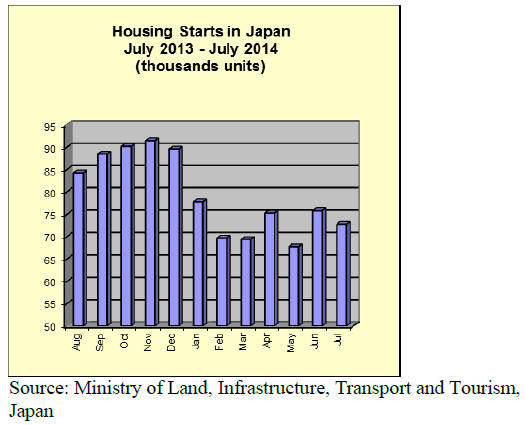
Yen moves above 103 to the US dollar
The Japanese yen:dollar exchange rate altered
significantly towards the end of August as funds were
withdrawn from the „safe haven‟ Japan as tensions eased
in Ukraine and Iraq.
A yen:dollar exchange rate of over yen 103 to the dollar is
higher than what the BoJ appears to be targeting so if the
yen weakens further the BoJ may intervene.
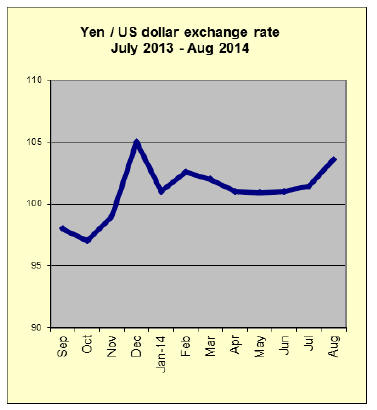
Trends in office, kitchen and bedroom furniture
imports
Japan‟s office, kitchen and bedroom furniture imports
from 2009 to the end of July 2014 are shown below.
Japan‟s imports of bedroom furniture increased in July
reversing the downward trend for the past two months.
Demand for imported kitchen furniture has improved
slightly but was capped by the weak housing starts.
Imports of office furniture have settled back into the
steady and unchanged levels seen before the peak just
before the consumption tax increase in April this year.
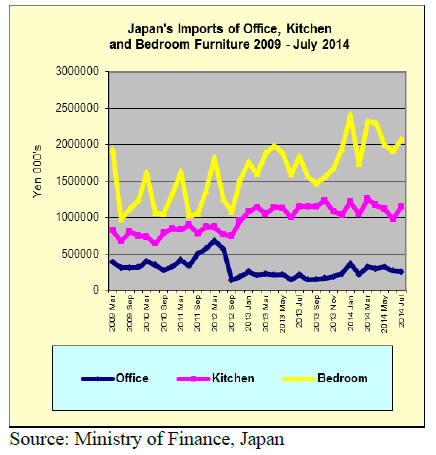
Office furniture imports (HS 9403.30)
Japan‟s July 2014 imports of office furniture were up 17%
compared to levels in July 2013. China remains the major
supplier (56%) with the bulk of the balance being supplier
from the EU, notably Poland, Italy Germany and Portugal.
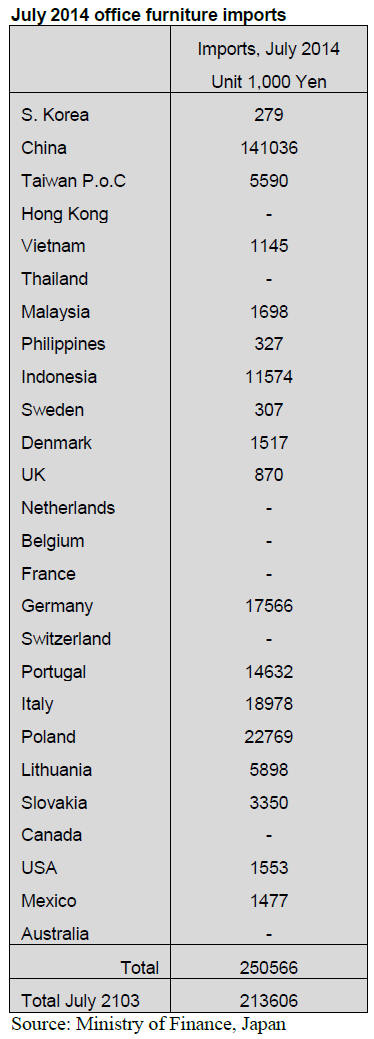
Kitchen furniture imports (HS 9403.40)
The top suppliers of kitchen furniture to Japan in July
continued to be Vietnam (40%), Philippines (21%) and
China (18%) which together supplied almost 80% of all
kitchen furniture imports in July.
The other major suppliers were all in SE Asia, Thailand,
Malaysia, Philippines and Indonesia with the last two
being the major suppliers in the region.
Year on year, July 2014 imports of kitchen furniture
barely changed from 2013.
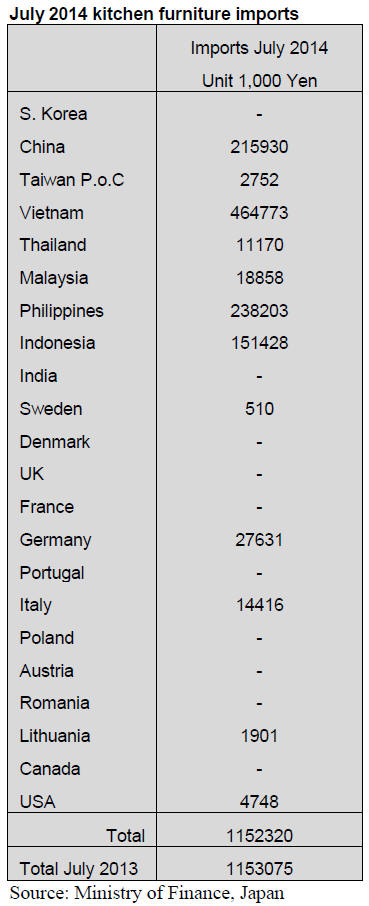
Bedroom furniture imports (HS 9403.50)
Year on year Japan‟s imports of bedroom furniture were
13% up on levels in July 2013 and were also higher than
in June this year.
China, Vietnam and Thailand dominated bedroom
furniture imports in July as they have since the beginning
of the year. Other major suppliers include Malaysia,
Poland and Romania.
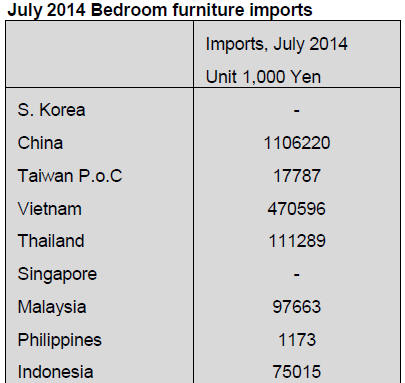 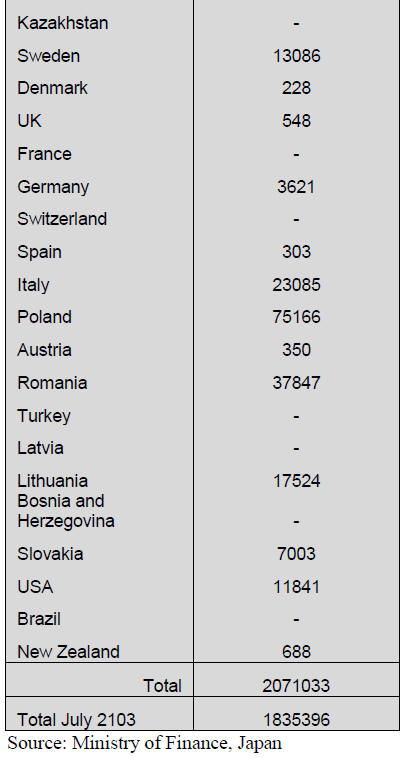
Trade news from the Japan Lumber Reports (JLR)
The Japan Lumber Reports (JLR), a subscription trade
journal published every two weeks in English, is
generously allowing the ITTO Tropical Timber Market
Report to extract and reproduce news on the Japanese
market.
For the JLR report please see:
http://www.nmokuzai.
com/modules/general/index.php?id=7
Revision of JAS rules on 2x4 lumber
The Ministry of Agriculture, Forestry and Fisheries drew
up revised JAS rules on 2x4 lumber. The main change is
to classify domestic cedar, cypress and larch to reflect
physical characteristics and strength of domestic species
properly since the original rule was made based on North
American lumber.
Domestic species have been classified and adapted same
as North American lumber standard. As more domestic
species have been used for 2x4 construction, it becomes
necessary to have own rules fordomestic species to
evaluate the characteristic correctly.
There are accumulated data on domestic species, which is
another background for the revision. Restriction on ring
count is also revised. In the past, the rule is that core wood
does not have enough strength so that wood with more
than 6 mm ring count is automatically graded as the lowest
grade but now domestic cedar, cypress, larch, Southern
yellow pine are excluded from the ring count restriction to
evaluate original performance properly.
There will be a new rule on MSR vertical edge glued
lumber, which allows utilization of short lumber for
sawmills.
South Sea(tropical) logs
South Sea log export prices continue firm with low log
production. Weather in Sarawak, Malaysia has been dry
and water level of rivers is low, which makes log towing
difficult. In particular, log supply in Tanjung Manis,
where majority of logs come by rivers, is tight.
India‟s purchase has been very aggressive after Myanmar
banned log export. India is now buying Sarawak low grade
logs for plywood mills. This pushes log export prices up.
Currently, meranti low grade prices are about $270 per
cbm FOB. The demand in India is brisk and with their
currency Rupee getting strong so export log prices seem to
stay up high by India‟s robust demand.
Log prices for Japan, which needs quality logs and
selected logs, are pushed up by strong log prices for India.
Current meranti regular log prices are US$280-295 per
cbm FOB. Small meranti prices are US$245-260 and super
small meranti prices are about US$230.
In PNG and Solomon Islands, log supply decreased by
prolonging rain so that the prices remain firm.
In Japan, log market continues depressed by reactionary
demand drop after the consumption tax hike in April.
Accordingly, the market has no room to accept higher
FOB prices but supply side has been tight in log supply
since last February even after rainy season was over in
June when log prices slacken normally but this year is
different with log prices staying up high. If this high level
continues through summer then rainy season starts in fall,
further increase of log prices is possible as log supply
decreases again in rainy season.
Plywood
Domestic softwood plywood market is weakly holding.
The demand slowed down since May after the
consumption tax increase. Shipment from plywood mills
dropped and the inventories started increasing.
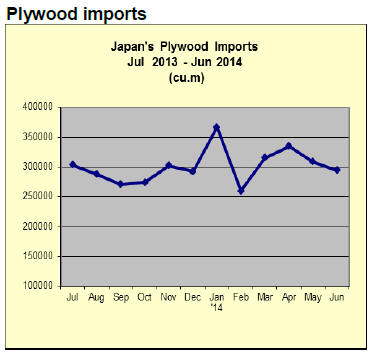
Because of this, all the softwood plywood mills started
curtailing the production since late June and this time they
are all making the same pace orderly to stop decline of the
market. The market reacted favorably to this action and
the trading has been normal without any confusion until
middle August.
However, the production curtailment actually started in
July and June statistics did not reflect this move.
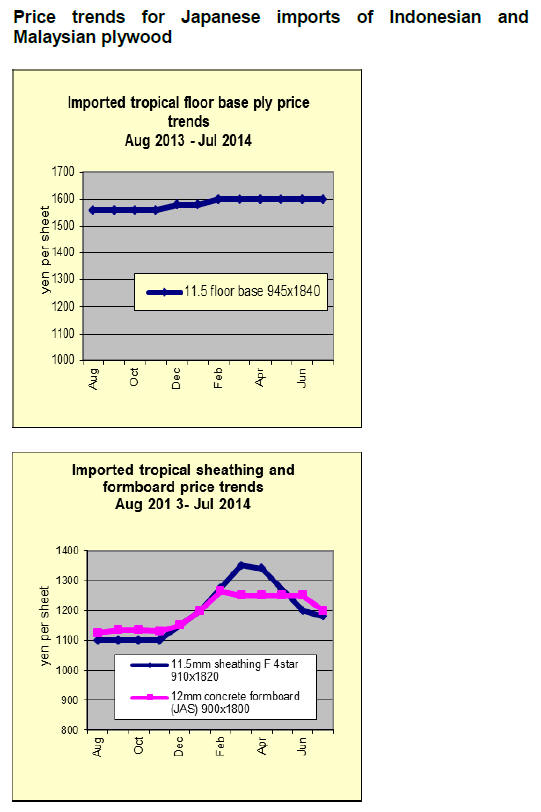 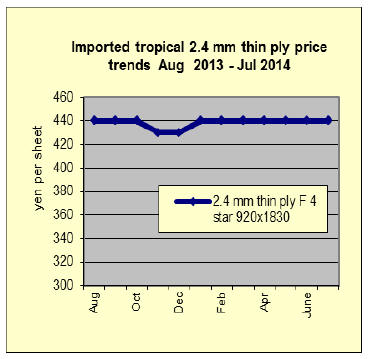
The Ministry of Agriculture, Forestry and Fisheries
disclosed June statistics. The production of softwood
plywood was 231,500 cbms, 3.7% more than June last
year and 4.4% more than May while the shipment was
178,700 cbms, 18.9% less and 0.1% less. The inventories
were 212,000 cbms, 33.6% more than May so the
inventories finally reached about 0.9 month for the
production.
Current market prices of 12 mm 3x6 panel in Tokyo
region are yen 940-950 per sheet delivered, 10 yen down
from July.
Imported plywood market is bottoming. Since late May,
the market started slackening with slow
demand but with continuous higher export prices by the
suppliers, the importers finally started stop under selling
since late July and asking higher prices and wholesalers
and dealers have started making procurement with bottom
feeling.
Nevertheless, the demand has not really recovered and
with ample port inventories, the importers struggle to pass
higher prices. Current market of 3x6 JAS concrete forming
panel for coating is yen 1,300-1,340 per sheet delivered,
unchanged from July.
Import of North American logs for the first half of 2014
According to the summary the tallying organizations made
up, total import of North American logs were 1,789,000
cbms, 4.3% more than the same period of last year.
Logs for sawmills in major Douglas fir ports like Kure,
Matsunaga and Kashima decreased considerably by mills‟
slower production but log arrivals increased for the ports
like Ishinomaki and Sakai Minato where plywood mills
are so increase of logs for plywood mills offset decrease of
logs for sawmills.
Volume for top three port of Kure, Kashima and
Matsunaga where Chugoku Lumber and other major
Douglas fir sawmills like Toa decreased and total of three
ports was 852,000 cbms, 13.6% drop and share of three
ports in total import was 47.6%, 7.6 points down from the
same period of last year. Another port of Matsuyama
where another large Douglas fir sawmill, Tsurui Sangyo
islocated, showed 19% decline as well.
|